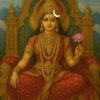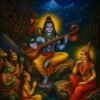Matrika Bhairava
Matrika (Sanskrit- मातृका) is a sanskrit word that symbolizes Motherly Energies whereas Bhairava means The fierce, powerful and fear-destroying form of Shiva. Matrika Bhairava is the form of Swacchanda Bhairava Shiva Himself — who embodies within Him all the Matrikas, such as the Ashta Matrikas, the Shodasha Matrikas, and the Varna Matrikas. He also embodies










